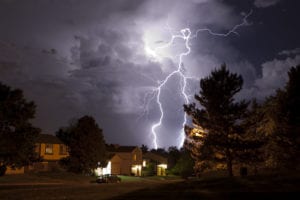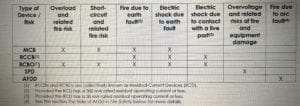Ever since the Current War between Tesla and Edison back in the 19th century, there has been controversy about the benefits and risks of electricity. Electricity has been a major part of our lives, and will be for the foreseeable future. Nevertheless, it can pose risks to persons and property if not treated with caution and if electrical installations are not properly designed, constructed and verified, with appropriate protective equipment in place. Existing electrical installations should also be periodically inspected and tested at appropriate intervals, and remedial works and improvements carried out where found necessary.

BS 7671: 2018
BS 7671: 2018 (the IET Wiring Regulations 18th Edition) provides requirements and recommendations for the design, erection, initial verification and periodic inspection and testing of electrical installations so as to provide for safety and proper functioning for the intended use.
As far as electrical installation products are concerned, properly selected and installed protective devices, such as in distribution boards, consumer units and other such electric equipment, are important keys to minimising risk of, amongst other things, fire and electrocution. Modern protective devices such as RCCBs, RCBOs, MCBs, SPDs and AFDDs provide protection against the risks listed below, in accordance with the relevant provisions of BS 7671: 2018.
 With new loads coming into our electrical installations, BS 7671 is constantly evolving, and each revision offers significantly more protection for people, property and livestock than previous editions.
With new loads coming into our electrical installations, BS 7671 is constantly evolving, and each revision offers significantly more protection for people, property and livestock than previous editions.
See the publication of BEAMA relating to electrical safety in residential buildings.
New Types of Loads
Electric vehicle charging equipment, solar photovoltaic (PV) inverters, electric heating and many more loads are being added to existing structures. By 2050 this is expected to lead to the demand for electricity being more than double today’s. The existing electrical distribution infrastructure will be able to handle the peak demand up until 2024/25, according to the National Grid Future Energy Scenarios 2019 study.
Therefore an important challenge within electrical installations is, and will be, to apply appropriate and sufficient protection for these technologies, to provide for safety.
EV Chargers:

Electric vehicles are becoming increasingly popular, and charging stations need appropriate protection for all users. EV charging points are subject to intensive plugging and unplugging, often by non-technical users. Many charging points are located outdoors, where the risk of electric shock can be greater than indoors. For each EV charging point incorporating a socket-outlet or a vehicle connector complying with BS EN 62196 series – irrespective whether installed at residential or non-residential premises – RCD protection is required by one of the following*, having a rated residual operating current not exceeding 30 mA and disconnecting all live conductors:
- RCD Type B or
- RCD Type A or F together with equipment that provides disconnection of the supply in case of a DC fault current above 6mA.
* Except where the EV charging equipment provides protection against DC fault currents, in which case the use of a Type A RCD is permitted. If the circuit supplying the charging point uses the protective measure of electrical separation, the RCD protection is not required.
The RCD provides protection against the relevant risks shown in the table above.
Also, where relevant, protection against electric shock risk due to a broken supply PEN conductor is required for an EV charging point located outdoors or which might be used to charge an electric vehicle outdoors. This is the case if the charging point is earthed to a PME earthing terminal provided by the electricity distribution company. Protection against this particular risk can be achieved by purpose-designed protective devices incorporated into the charging point or installed in conjunction with it. (Regulation 722.411.4.1 of Amendment 1 to BS 7671: 2018 refers.) An RCD will not provide protection against this risk.
PV Inverters:

Despite the decelerating growth in 2020, solar power generation is expected to keep increasing through on-grid or off-grid on-site installations. This highlights the importance of correct protection. A PV inverter with at least a simple separation between the AC and DC circuits cannot pass DC residual currents through to the AC side. By contrast, a PV inverter without this separation can pass DC residual currents through to the AC side, unless the design of the inverter prevents this.
The RCMU (Residual Current Monitoring Unit) in a typical inverter without simple separation is set for 300 mA steady residual currents, and for sudden changes in residual current of 30mA and higher. However, this does not prevent DC residual currents exceeding 6 mA but less than the lower threshold value of the RCMU on the AC side of the system. Consequently, RCD protection by means of a Type B RCD in accordance with BS EN 62423 is required by BS 7671, unless the inverter, by design, is not able to supply DC fault currents into the electrical installation. (Regulation 712.411.3.2.1.2 of BS 7671: 2018 refers.)
Heating cables and embedded heating systems for surface heating (such as floor heating):
Circuits supplying these heating units are required by BS 7671 to be provided with additional protection by RCDs having a rated residual operating current of not more than 30 mA. (Regulation 753.415 of BS 7671: 2018 refers.)
Important Note: Choosing the correct type of RCD depending on their behaviour in the presence of DC components and frequencies:
Specific requirements for the type of RCD to be selected for some particular types of load are mentioned above. In addition, however, the general requirements of Regulation 531.3.3 must be complied with in order to choose the correct type of RCD (Type AC, A, B or F) for a circuit, to suit the residual current waveform of the type(s) of load for which the circuit is intended. This is essential for proper and effective operation of RCDs.
The Role of AFDD in Fire Safety
One of the dangers of electricity is its potential for causing fire. In England alone during the 2018/19 period, there were 36700 electrical incidents in buildings which caused fire, according to the fire statistics. The sources of fire listed in majority of incidents were located in electrical distribution, although many were also in current-using equipment.

Deteriorated or damaged cables or electrical connections, loose connections (which can be due to something as small as an untightened screw) or faulty current-using equipment can lead to an irreversible incident. Such causes can lead to arc faults which can result in fire.
Due to their characteristics, electric arcs cannot be detected by fuses, circuit-breakers (e.g. MCBs, MCCBs) or RCDs. Therefore, devices having a specific capability of detecting arcs faults are needed. These are called Arc Fault Detection Devices (AFDDs).
BS 7671:2018, the IET Wiring Regulations 18th Edition, recommends the use of AFDDs conforming to BS EN 62606 as a means of providing additional protection against fire caused by arc faults in AC final circuits.
Each year, UK government runs the Fire Kills Campaign across the UK to raise awareness of electrical fire risks and the simple steps that people can take to avoid a devastating fire in their homes. Electrical Safety First, a campaigning charity that aims to reduce deaths and injuries caused by electricity in UK homes, also works towards this target and runs the Electrical Fire Safety Week working together with the Fire & Rescue Services.
For more information about 2020 campaign check out Electrical Fire Safety web site.


